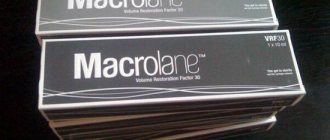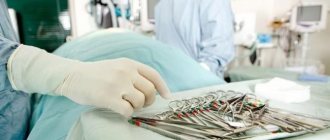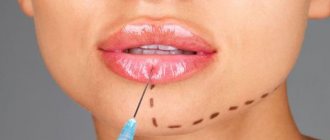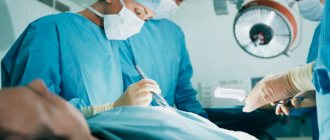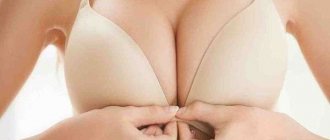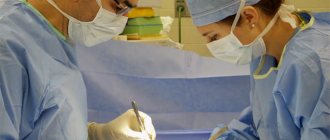Types of implants
The implant consists of a dense silicone shell and a cohesive gel or sterile saline solution. Silicone endoprostheses are more popular because they are particularly durable at an affordable price. As a result of the contraction of the calf muscles when walking, the shape of the lower leg is constantly changing, so the implants must be sufficiently elastic. Endoprostheses must be selected in such a way that they match the shape of the contracting muscles.
The shapes of implants are:
- symmetrical, resembling a crescent moon;
- asymmetrical (anatomical) with a projection shifted upward relative to the center - their upper third is the most voluminous.
The surface of endoprostheses can be either smooth or rough (textured). Endoprostheses with roughness fuse better with the surrounding tissues, which ensures more long-term and stable results of surgical correction.
Method of performing cruroplasty for calves and shins
The operation consists of several stages:
- the patient is given general or epidural anesthesia,
- after antiseptic treatment of the operating area, the surgeon makes an incision in the popliteal area,
- between the fascia and the calf muscle, with the help of instruments, a free space for the implant is formed,
- the endoprosthesis is placed in the created pocket,
- do the same with the other leg,
- If the effect is satisfactory, sutures are placed on the incisions.
Cruroplasty lasts about an hour.
To learn how cruroplasty is performed, watch this video:
Preparing for surgery
The preparatory stage includes:
- consultation with a plastic surgeon to identify indications/contraindications, choice of endoprostheses, volume of intervention and type of access;
- comprehensive clinical and laboratory examination;
- consultations with a therapist, cardiologist and anesthesiologist.
The duration of the preparatory stage is about two weeks, during which the patient is recommended to:
- stop taking medications that worsen blood clotting (hormonal drugs, vitamin E, anticoagulants);
- stop smoking and drinking alcohol: under the influence of alcohol and nicotine, the blood thins, which increases the risk of postoperative bleeding and the formation of hematomas;
- limit the consumption of salty foods to prevent swelling after correction;
- stop training 3 days before surgery;
- Do not eat or drink on the day of surgery.
Carrying out
Before the operation begins, the patient is given an epidural or spinal anesthesia. Rarely can endotracheal anesthesia be used. The effect of the anesthetic lasts for 40-90 minutes.
The entire course of the surgical process is carried out in the performance of certain actions.
First, the doctor applies special markings to the shins. This is necessary to identify areas that require correction. Next, the affected area is treated with a degreasing solution to remove contaminants from the surface of the skin.
It is also worth noting that it is at this stage that the specialist makes the bed where the implant will be installed. During this process, an incision is made on the skin, the size of which does not exceed 4 centimeters. To form the so-called pocket, the soft tissue is separated from the popliteal fascia.
Next, an endoprosthesis is installed in it and its location is corrected. As a rule, the placement of this element occurs under the fascia or muscle.
After this, the surgical wound is sutured. The surface is covered with an overlay and a medical bandage.
How is the operation performed?
According to experts, tibia plastic surgery is a technically simple operation lasting about 1 hour. Surgery is performed under endotracheal anesthesia, epidural or spinal anesthesia. Most often, the skin for installation of the endoprosthesis is cut in the popliteal area in a natural fold, so the seam is almost invisible. The size of the incision is about 3...4 cm.
During surgery, the patient usually lies on his stomach. After treating the surgical field with an antiseptic composition and making markings, the surgeon makes an incision and prepares a “pocket” for the implant. Such a pocket should best match the size and shape of the endoprosthesis, which will become a logical continuation of the muscle.
There are two ways to install an endoprosthesis:
- subfascial - under the connective tissue membrane of the calf muscle - a more popular method, in which the volume of the lower leg is adjusted only in the required place, the implant is well fixed, cannot change its location, is completely covered by the surrounding soft tissues and is practically not palpable;
- submalar - under the calf muscle.
After installing the implant, the surgeon sutures the fascia and subcutaneous fat. A cosmetic suture is applied to the skin. The incision site is protected with a pressure bandage.
The most frequently asked questions about shin surgery (cruroplasty):
How strong are the implants?
Will the implants be visually noticeable?
Will the implants need to be replaced after a few years?
During shin surgery, implants are installed under the fascia of the calf muscles, which perfectly hides its presence both visually and tactilely. The presence of implants can only be determined by a specialist through targeted palpation. In the first days after surgery, some discomfort is possible, similar to a feeling of a stretched calf muscle, but this feeling is completely relieved by taking painkillers. After 3-4 weeks, the pain completely disappears, and the installed implants do not affect your lifestyle in any way.
As mentioned above, the operation of contour augmentation of the legs gives excellent aesthetic results if two rules are observed: the correct choice of implants (volume and geometry) and the most accurate determination of the level of their installation. Installation of excessively large implants can lead to a pronounced contour of the prosthesis and a clear violation of anatomical proportions. Installing implants under the muscle fascia completely eliminates the possibility of visual recognition.
Modern implants are filled with cohesive silicone gel and come with a lifetime warranty. The safety of the materials has been proven over decades of use in aesthetic medicine and there is no need to replace them over time.
Postoperative period
The total duration of the rehabilitation period after plastic surgery is 1.5-2 months, of which the patient spends the first 2-3 days in the hospital:
- 2 hours after the operation you can stand on your feet or lie on your back.
- The pain goes away in 3-5 days, but during the first three weeks some discomfort may be felt in the calf muscles when walking (the cause of the pain is tension in the popliteal fascia).
- From 4-5 days of the postoperative period you can take a shower.
- The sutures are removed 7-10 days after plastic surgery, during which time the patient is observed on an outpatient basis by a surgeon. Final healing of the wound occurs in an average of three weeks.
- Swelling in the lower leg area completely disappears in 2-4 weeks. To reduce swelling and discomfort, the patient is recommended to move only around the house in the first days after cruroplasty and, while in bed, keep his legs elevated.
- Once the protective bandages are removed, the patient can return to their normal activity regimen, which includes walking—first short walks and then longer walks. This is how the skin and muscles quickly get used to the new shape of the lower leg. However, you should return to your usual physical activity no earlier than after 1 month.
- In the first month of the postoperative period, the patient must wear compression garments (stockings, tights or knee socks) and use shoes with a heel of 4-5 cm.
- Active sports, visits to the solarium, swimming pool, bathhouse, sauna are allowed no earlier than after 1-3 months (it is best to consult a plastic surgeon about this).
After operation
The patient spends 1-2 days in the clinic. Afterwards, he is discharged. Sutures are either self-absorbing or cosmetic sutures that require removal. It’s good if the patient can come to the clinic once every 3 days for dressings. But if this is not possible (for example, a person lives in another city), he is given an intradermal self-absorbing cosmetic suture, which must be lubricated with brilliant green every other day.
Postoperative rehabilitation is a very important point. Unlike a one-time operation, rehabilitation takes a long time and requires some restrictions and self-discipline from the patient. For the first 7-10 days, you should wear shoes with heels 4-5 cm high. This will relieve the calf muscles a little. The fact is that in the first month after surgery, a “layer” is formed in the tissues of the lower leg between the implant and the muscle; in other words, the body envelops the foreign body (implant) with a capsule. Therefore, during this period - about 1 month, it is necessary to treat this area with care, not to play sports, and not to overload the leg muscles. A useful thing is compression garments. It must be worn for at least a month after surgery and is put on immediately after surgery.
Possible complications
In the vast majority of cases, no serious complications are observed with cruroplasty; at the end of the rehabilitation period, the operated legs cannot be distinguished from natural ones in appearance, the endoprostheses cannot be palpated, and the scars in the natural fold under the knee are almost invisible.
However, like any surgical intervention, cruroplasty can be accompanied by complications - general (characteristic of all operations) and specific. Specific complications after plastic surgery include:
- Formation of a hematoma in the popliteal fossa;
- Seroma is an accumulation of serous fluid in the muscles around the endoprosthesis, caused by the reaction of adjacent tissues;
- Suppuration of a postoperative wound;
- Capsular contracture is the formation of a dense connective tissue membrane around the endoprosthesis, compressing the implant and deforming the contour of the lower leg;
- Dystopia of the endoprosthesis - displacement of the implant away from the installation site due to violation of the bandaging regime or improper formation of the “bed”;
- Asymmetry in the size and shape of the legs with significant tissue swelling or incorrect choice of implant;
- Contouring of the endoprosthesis - “bulging out” the contours of the implant, the dimensions of which turned out to be too large;
- Formation of rough keloid-type scars;
- Complete or partial loss of skin sensitivity on the inner or outer surface of the leg due to damage to the large or small cutaneous nerves during rough operation.
The fears of some patients about the negative impact of plastic surgery on the condition of the veins are not justified.
Indications for leg implants
Cruroplasty is performed on anyone who is dissatisfied with the appearance of the calf area if there are objective reasons:
- a thin layer of muscles in this area, disrupting the overall harmony of the legs,
- curvature of the legs due to the characteristics of soft tissues with normal bone structure,
- muscle wasting caused by injury or disease (poliomyelitis, clubfoot, congenital neural tube defect).
Reviews
Yana, 30 years old
“I can’t help but share my experience. In general, 4 years ago I long-awaitedly corrected the shape of my legs. Why is it long-awaited? Well, I’ve been tormented all my adult life, I heard a couple of times from doctors that I had false curvature of my legs, but I didn’t dare to have an operation, I didn’t have money, or I had time - work, children. But at the age of 43 it got stuck. And what a fool I was for not doing this earlier, before that I didn’t even have skirts in my wardrobe. The operation is a real chance to get rid of a bunch of problems, including defeating your inner “cockroaches”. It took no more than a month to recover. at least within a month I was back on my heels))) objectively, I could have done it earlier, but I decided to play it safe. I definitely don't regret it. Not a bit."
16-08-2012
Alina, 27 years old
“Why I decided to do it is probably clear from the essence of the operation, my legs are thin and crooked. I’ve been wearing pants all my life, and then only in wide ones, and it doesn’t matter that it’s 35 degrees outside. Only abroad, running to the sea with open legs. The operation corrected not only the problem of my legs, but my whole self, I adore myself, my legs and summer! I won’t say that rehabilitation is very painful, but for the first couple of days on painkillers, it’s better to rest and walk less. After a week you can more or less walk long distances, after 2 weeks the pain practically goes away, after a month you remember about the operation only because you still need to take care of your legs, and after two weeks you forget that there was some kind of intervention. Almost 2 years have passed since the plastic surgery, I can’t feel the implant at all, it’s almost impossible to find it with my hands, it’s almost impossible to feel it, I can’t feel it, I know where it is, but I can’t find its outline with my fingers, the doc can, but they somehow feel to another. Apparently technology. The feeling in heels is normal, nothing new. At first it is easier to walk on a small wedge. The thought of regret never occurred to me, because after the operation the quality of my life changed, I adore my doctor, who gave me such happiness, I walk around in skirts with my head held high. I will be grateful to him all my life for my beautiful, slender legs!”
04-09-2014
Vika, 36 years old
“I had surgery! After 3 hours I already crawled to the mirror to look at the result, barely of course, half bent. I feel now as if I never did. I don’t feel the implants at all, sensitivity has returned. I move around as usual. I feel just great!!!”
20-05-2015
More
Preparation and description of the procedure
The patient undergoes a full examination and takes the necessary tests before he undergoes shin surgery. This makes it possible to determine the presence of contraindications to cruroplasty. The surgeon preliminarily examines the person, tells him about the features, and selects suitable implants. He must be healthy at the time of surgery. 2 weeks before surgery you need to stop smoking, alcohol, and taking certain medications. The day before, you should not eat food.
Plastic surgery is performed under epidural anesthesia, and in some cases under general anesthesia. Duration – from 40 minutes to 2 hours. The procedure looks like this:
- an incision is made in the natural fold of the popliteal fossa (in this place the scar is practically invisible);
- a pocket is formed under the fascia;
- an implant is inserted, which is additionally covered with a fibrous membrane (this guarantees reliable fixation of the prosthesis);
- the incision is sutured, and a sterile bandage is applied on top.
After 3 hours the patient can already get back on his feet.
Postoperative period
As a rule, after 2-3 days they are discharged from the hospital, the stitches are removed on 7-10 days. The patient must follow all recommendations at home, wear special compression stockings and tights. Rehabilitation lasts up to two months. For the first few weeks, you may feel pain in your legs, which can be relieved with painkillers prescribed by your doctor.
Doctors recommend wearing high-heeled shoes (5 cm) for the first 5–6 days after implant installation. This will reduce pain.
The wound heals completely in 2–3 weeks. All this time it must be treated with antiseptics. The swelling that forms after plastic surgery goes away in about a month. The rehabilitation period lasts 2–3 months, after which the person can return to normal life and play sports.
Complications
Like any operation, plastic surgery of the legs threatens the development of some complications:
1. bleeding, both during and after the procedure;
2. suppuration as a result of wound infection during surgery, in the postoperative period;
3. deformation of the contour of the leg due to the formation of dense connective tissue around the implant (capsular contracture);
4. displacement of the implant, which leads to asymmetry of the legs (as a rule, this occurs due to the negligence of the surgeon or incorrectly selected prostheses);
5. formation of rough scars (scars remain due to the characteristics of connective tissue);
6. decreased sensitivity in the area of intervention.
There are cases when a patient requires repeat plastic surgery of the legs. The reason is incorrectly selected implants. The old prosthesis is removed, and six months later a new, more suitable one is inserted in its place.
Advantages and disadvantages
Advantages of cruroplasty:
- if the patient does not like the result obtained, then it can be corrected - remove the implant or replace it with a more suitable one;
- high-quality implants are very durable, which allows a person to lead a normal lifestyle without fear of damaging the prosthesis;
- a lifetime guarantee on implants is given;
- rehabilitation does not take much time;
- Side effects are quite rare.
Flaws:
- the fascia may rupture, which leads to undesirable consequences;
- if the size of the implant is selected incorrectly, you will have to resort to repeated surgery;
- if the doctor is not professional enough, the implant may be installed incorrectly, which leads to asymmetry of the legs.
Question answer
What is preferable to choose: gel correction or implant installation?
It is possible to visually increase muscle mass by correcting thin shins using cruroplasty. Improper administration of the gel can serve as a site for the development of infections and inflammation if the patient’s body rejects the material. Rejection can occur both in the first 30 days and 12 months after plastic surgery. This cannot happen with implants. In addition, after a certain period of time, the gel correction becomes deformed and loses its shape, which cannot happen with cruroplasty.
Are there any contraindications to cruroplasty for varicose veins?
Not performed for varicose veins. First of all, it is necessary to get rid of varicose veins, then perform plastic surgery. It is impossible to combine two operations - removal of the affected veins and correction of the calf areas. Cruroplasty can be performed no earlier than 5-6 months after curing varicose veins.
Will it be possible to wear heels after surgery? After what time?
You can and even need to wear shoes with heels. During the postoperative recovery period, you need to walk in low heels for several minutes every day, increasing the time daily. The procedure will reduce pressure on the muscle tissue of the lower leg and reduce rehabilitation after surgery. After a month, you can wear high-heeled shoes on a regular basis. There is no need to worry about the durability of the implant - it does not move or turn over when walking in heels.
Will plastic surgery correct leg asymmetry? One shin is thicker than the other.
Yes, in most cases, shin plasty can eliminate asymmetry of the lower extremities. To do this, it is necessary to correct the shin of a smaller volume by sewing in a calf implant. But this is not always possible, since sometimes not only the soft tissue of the legs varies, but also the structure of the bone. In this case, larger liposuction of the lower leg is recommended.
How soon can you start driving?
Restrictions on driving a car are lifted individually as the pressure in the lower leg muscles decreases and cramps are eliminated. As a rule, the patient is allowed to drive after two weeks.
Indications for lower leg replacement include:
- Restoration of muscles in the presence of atrophy, manifested as a consequence of various diseases;
- Congenital inexpressiveness of the muscle tissue of the lower leg;
- Surgical rehabilitation of legs after accidents and serious injuries;
- True and false curvature of the legs.
To replenish the contours and increase the volume of the legs, specially designed implants are used; they are selected during an individual consultation in accordance with the anatomical features and wishes of the patient. Modern implants for shin augmentation are available in various volumes and geometries, with a textured or smooth surface (shell).
The operation is also performed for curvature of the legs. There is a distinction between true and false curvature. True curvature of the legs is congenital
a feature of the anatomy of the lower extremities, which is associated with deformation of the tibia. Externally, the defect manifests itself from the perineum to the closed ankles along the outer contour (O-shaped curvature) or the impossibility of closing the ankles with the thighs closed in a free position (X-shaped curvature).
False curvature of the legs
- this is a structural feature of the lower extremities in which there is no bone deformation. This type of curvature is associated with the distribution of soft tissues in the lower leg area. Contour plastic surgery is successfully used to correct shins with false and moderately expressed O-shaped curvature of the shins. In the postoperative period, a mandatory condition is to limit physical activity for an average of a month. You should also wear compression garments for a month after surgery.
Plastic surgeons and clinics specializing in Cruroplasty surgery:
Mamedov Rusif Plastic surgeon
Specialization
- Mammoplasty
- Rhinoplasty
- Facial plastic surgery
Sergey Demin Plastic surgeon
Specialization
- Mammoplasty
- Abdominoplasty
- Lipofilling
- Liposuction
Farhat Fuad Plastic surgeon
Specialization
- Mammoplasty
- Abdominoplasty
- Cruroplasty
- Liposuction
Comments and questions
Karina 12/03/2017 at 03:42 pm # Reply
Thank you very much for such detailed information about this type of operation

